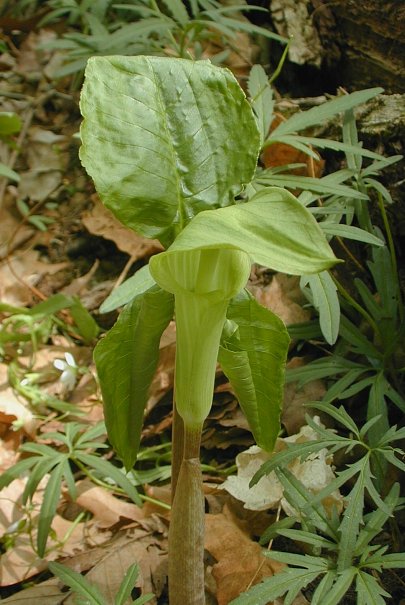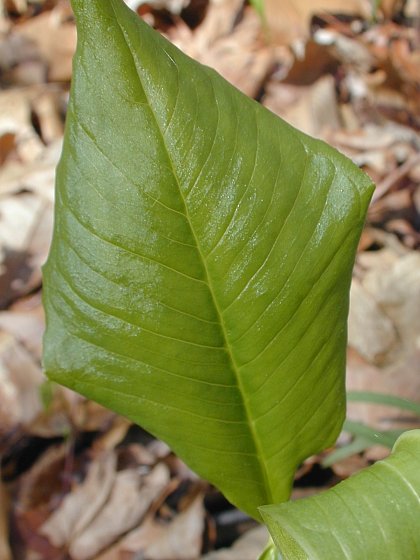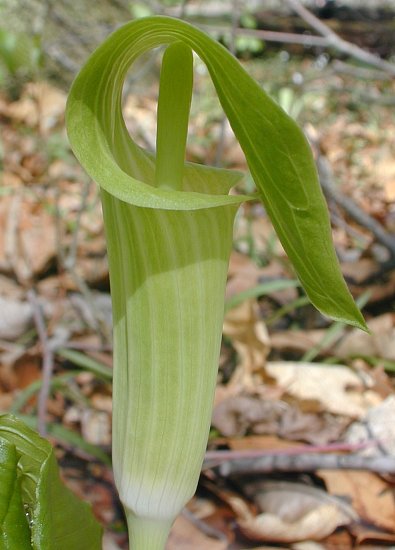Description: This perennial plant is about 1-2' tall. It consists of 1-2 trifoliate leaves with long petioles and a stout peduncle (or stalk) with a single flower at its apex. Both the petioles and the peduncle develop directly from the corm; the peduncle is wrapped by a sheath at its base and it is shorter than the petioles. They both have a smooth hairless surface, and their color varies from light green to reddish green or brownish green. The light green to dark green leaflets are up to 7" long and 3" across; they are ovate or broadly rhombic, pinnately veined, glabrous, and smooth along the margins. The terminal leaflet is larger than the lateral leaflets. Jack-in-the-Pulpit is usually monoecious, but some plants are unisexual and they have the capability to change their gender. The whitish green to reddish green flower is about 3½" long and 2" across, consisting of a spadix and spathe. The light green spadix is cylindrical in shape; the male flowers are located above the female flowers on the lower half of the spadix, where they are hidden from view by the surrounding spathe. These flowers are tiny in size and they lack corollas and calyxes. The male flowers have several stamens, while the female flowers have a single pistil. The spathe loosely surrounds the spadix, exposing only its upper portion (the "Jack" of the flower). The upper part of the spathe develops behind the spadix and then curves over it, providing a protective hood (the "Pulpit" of the flower). This spathe varies from light green to reddish green in color; its tubular base is slightly furrowed and often has white or burgundy stripes.

The blooming
period occurs from mid- to late-spring and lasts about 2 weeks,
although the spadix and spathe remain attractive for a longer period of
time. The flowers may emanate a faint scent that resembles stagnant
water or fungi; if so, it is difficult to detect through the human
nose. If cross-pollination occurs, each fertilized flower will develop
a fleshy red fruit about ¼" across; this fruit contains one or more
seeds. Collectively, these fruits can form an ovoid mass up to 2" long.
The root system consists of a corm up to 1½" across with secondary
roots.
Cultivation:
The preference is dappled sunlight to light shade during the spring,
when vegetative growth and flowering occurs; medium shade is tolerated
later in the year. The soil should be moist to mesic and contain an
abundance of organic material from decaying leaves and other material.
It is easier to start plants from corms, rather than seeds.

Range &
Habitat:
The native Jack-in-the-Pulpit is a fairly common plant that occurs in
every county
of Illinois (see Distribution
Map). Habitats include mesic deciduous woodlands and shady
hillside seeps. This species typically occurs in original woodlands
that have never been subjected to the plow or bulldozers.
Faunal Associations:
The flowers are pollinated by fungus gnats (Sciaridae &
Mycetophilidae) and the larvae of parasitic thrips. In particular, the
oligolectic thrips Heterothrips arisaemae and
probably Ctenothrips
bridwelli are attracted to the flowers of
Jack-in-the-Pulpit. The foliage and corms (especially the latter)
contain crystals of calcium oxalate, which can cause a burning
sensation in the mouth and irritation of the gastrointestinal tract. As
a result, mammalian herbivores rarely eat this plant. However, some
upland gamebirds feed on the foliage occasionally, including Meleagris
gallopavo (Wild Turkey). The red berries are eaten by some
woodland birds, including Hylocichla mustelina
(Wood Thrush) and the Wild Turkey.

Photographic
Location:
The photographs were taken at Busey Woods in Urbana, Illinois,
and at a woodlands near Kickapoo State
Park in Vermilion County, Illinois.
Comments:
Jack-in-the-Pulpit is a favorite woodland wildflower because of its
curious flowers. The closest relative of this species is Arisaema
dracontium (Green Dragon). Green Dragon also occurs in moist
to mesic woodlands, but it is less common in Illinois. Each flower of
Green Dragon has a long narrow spadix that protrudes above the spathe;
the latter is narrowly cylindrical. The foliage of these two species
differs as well: Jack-in-the-Pulpit has compound leaves with 3
leaflets, while Green Dragon has compound leaves with 5-13 leaflets.
The leaflets of the latter are more narrow than those of
Jack-in-the-Pulpit. In southern Illinois, there is a rare subspecies of
Jack-in-the-Pulpit, Arisaema triphyllum pusillum,
that is a dwarf version of the typical subspecies.